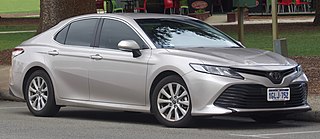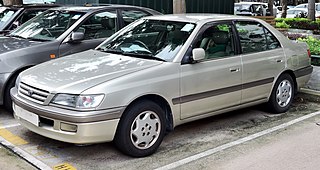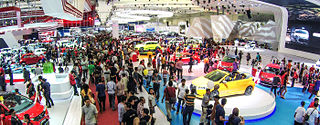
Daihatsu Motor Co., Ltd., commonly known as Daihatsu, is a Japanese automobile manufacturer and one of the oldest surviving Japanese internal combustion engine manufacturers. The company's headquarters are located in Ikeda, Osaka Prefecture.

The Toyota Camry is an automobile sold internationally by the Japanese auto manufacturer Toyota since 1982, spanning multiple generations. Originally compact in size (narrow-body), the Camry has grown since the 1990s to fit the mid-size classification (wide-body)—although the two widths co-existed in that decade. Since the release of the wide-bodied versions, Camry has been extolled by Toyota as the firm's second "world car" after the Corolla. As of 2022, the Camry is positioned above the Corolla and below the Avalon or Crown in several markets.

The Toyota Corona is an automobile manufactured by the Japanese automaker Toyota across eleven generations between 1957 and 2001. On launch, the Corona was Toyota's second-highest product in their range, just below the Crown. The Corona was marketed in the JDM at Toyota's Toyopet Store dealership channels, and the Corona was one of Toyota's first models exported to other global markets, followed by the smaller Toyota Corolla.

The Daihatsu Terios is a mini SUV produced by the Japanese automobile manufacturer Daihatsu since 1997 as the successor to the F300 series Rocky. It was initially offered in both short- and long-wheelbase configurations before the former stopped production in 2016 to be replaced by the A200 series Rocky crossover in 2019. The long-wheelbase variant is available mainly for the Indonesian market with three-row seating options. A smaller kei car model called the Terios Kid/Lucia was also available for the first-generation model.

The Toyota Kijang is a series of pickup trucks, station wagons and light commercial vehicles produced and marketed mainly in Southeast Asia, Taiwan, India and South Africa by Toyota between 1976 and 2007 under various other names.

The Toyota Mark II is a compact, later mid-size sedan manufactured and marketed in Japan by Toyota between 1968 and 2004. Prior to 1972, the model was marketed as the Toyota Corona Mark II. In some export markets, Toyota marketed the vehicle as the Toyota Cressida between 1976 and 1992 across four generations. Toyota replaced the rear-wheel-drive Cressida in North America with the front-wheel-drive Avalon. Every Mark II and Cressida was manufactured at the Motomachi plant at Toyota, Aichi, Japan from September 1968 to October 1993, and later at Toyota Motor Kyushu's Miyata plant from December 1992 to October 2000, with some models also assembled in Jakarta, Indonesia as the Cressida.
Astra International is an Indonesian conglomerate controlled by Jardine Matheson. It was founded in 1957 by Tjia Kian Tie, Liem Pen Hong with the name of PT Astra International Incorporated.

The Toyota Avanza and Daihatsu Xenia are a series of multi-purpose vehicles (MPV) developed by Daihatsu and marketed by both Toyota and Daihatsu, mainly sold with three-row seating. The Avanza and Xenia were developed as an entry-level MPV marketed mainly for the Indonesian and other emerging markets, and mainly produced in Indonesia by Astra Daihatsu Motor. Avanza's spiritual predecessor was the Kijang, whose model program has since been split into two different models to expand Toyota's reach in the MPV sector.

The Toyota Innova is a series of multi-purpose vehicles (MPV) manufactured by the Japanese carmaker Toyota since 2004, mainly sold with three-row seating.

The Toyota SZ engine family is a series of straight-4 piston engines with a forward-facing exhaust. Toyota Motor Manufacturing (UK) in Deeside produces SZ engines for the Yaris. All three types of the SZ engine are built in Tianjin FAW Toyota Engine Co., Ltd. (TFTE) Plant No. 1 in Xiqing District, Tianjin, China. The 2SZ-FE and 3SZ-FE variations are also manufactured by PT Astra Daihatsu Motor's Karawang Engine Plant in Indonesia.

The Toyota NR engine family is a series of small inline-four piston engines designed and manufactured by Toyota, with capacities between 1.2 and 1.5 litres.

The Daihatsu Ayla is a city car designed by Daihatsu and manufactured by Astra Daihatsu Motor in Indonesia since 2013, primarily developed for emerging markets. The Ayla has also been sold by Toyota as the Toyota Agya in Indonesia, South Africa, Tunisia and Americas, and the Toyota Wigo in the Philippines, Sri Lanka, Brunei and Vietnam through an OEM agreement. The car is also slightly reengineered and manufactured in Malaysia by Perodua as the Perodua Axia.

The automotive industry in Indonesia plays an important role to the economic growth of the nation, contributing 10.16 per cent of the GDP. Indonesia automotive product exports is currently higher in value than their imports. In 2017, Indonesia is the 17th largest passenger vehicle producer in the world and the 5th largest passenger vehicle producer in Asia, producing 0.98 million vehicles.

The Daihatsu Sigra is a mini MPV with standard three-row seating designed by Daihatsu and manufactured by Astra Daihatsu Motor in Indonesia since July 2016 to be sold exclusively in the country. Developed by Daihatsu chief engineer Nobuhiko Ono, it is built on lengthened Ayla's platform and positioned below the Xenia as a more affordable MPV option for the Indonesian market, where three-row MPVs have high demand in the country. It is also rebadged and sold by Toyota as the Toyota Calya with a differentiated front fascia. The cars were built to meet the "Low Cost Green Car" regulation by the Indonesian government that abolished luxury goods tax for economical cars.
PT Astra Daihatsu Motor is an automobile manufacturing company based in Jakarta, Indonesia. It is a joint venture company between Daihatsu, Astra International and Toyota Tsusho. It is the largest car manufacturer in Indonesia by production output and installed capacity, and has been second best-selling car brand behind Toyota. ADM also supplied most Toyota-branded models sold in Indonesia, which includes compact cars such as Avanza, Rush, Agya and Calya.

The Dynamic Force engines are a family of internal combustion engines developed by Toyota under the brand's Toyota New Global Architecture (TNGA) strategy. The engines can be fueled by petrol (gasoline) or ethanol and can be combined with electric motors in a hybrid drivetrain. The engines were developed alongside the TNGA family of vehicle platforms, as part of a company-wide effort to simplify the vehicles being produced by Toyota.

PT Timor Putra Nasional (TPN), commonly known as Timor, was an Indonesian automobile manufacturer operating between 1996 and 2000 originally formed by businessman Tommy Suharto. The company was created as a response to a presidential instruction (Inpres, Instruksi Presiden) regarding the development of the national car industry. The Indonesian government then appointed TPN as a sole 'national car pioneer'.
This is a list of concept vehicles made by Toyota from the years 2020–2029.



















